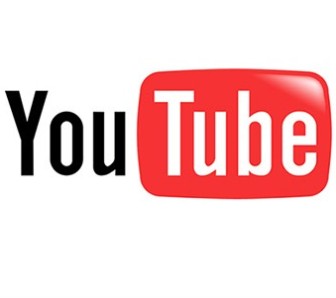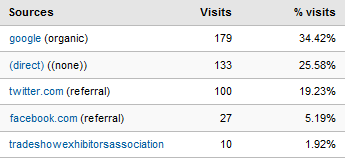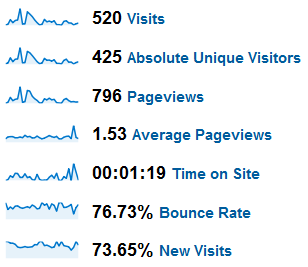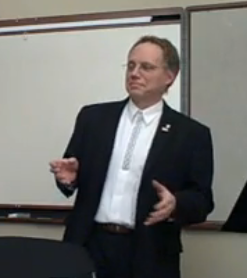Using Social Media with Tradeshows and Other Events
Pulled out the Flip Video Cam and recorded a few thoughts on using social media with tradeshows, conventions, conferences and events:
httpv://www.youtube.com/watch?v=5GJiDj8C6vQ
Pulled out the Flip Video Cam and recorded a few thoughts on using social media with tradeshows, conventions, conferences and events:
httpv://www.youtube.com/watch?v=5GJiDj8C6vQ
Tradeshow consultants and trainers sound like a broken record when they harp on how important it is for your front line people – the tradeshow staff – to be “on” all the time. To put their best face and effort forward. To respond with a smile. Etcetera.
In spite of how fast information spreads (like wildfire!), some tradeshow managers just don’t get it! So here’s a quick list of ways your staff can blow the next deal that may be walking into your booth. Pay close attention now and see if they’re making any of these mistakes:
Do your staffers show any of these symptoms of sabotage? You can teach them how to do things correctly (they might learn and pay attention – good). You can show them (better). Or you can get them to buy in to the whole marketing effort and mission of the company. When they believe – and understand a few common sense rules – they’ll happily become true ambassadors of your company.
And at that point they’ll be the best ‘front line’ people you can have.
Submitted by Rose Esposito of the Marcomm Group

Video is an increasingly important way for businesses to promote their products, services, and brand online. Tradeshow videos combine the power of video with the energy and excitement of the tradeshow environment to create high impact video that effectively presents your marketing message after the show has ended. It can help you reach those unable to attend or those who didn’t receive your complete message.
Video is also the medium of choice for post-show online ads, email blasts, additions to your website and Social Networking efforts. Understanding how to create a tradeshow video that captures attention, and how to promote it for maximum viewership after the show is critical.
Bob Lipp, founder of Trade Show News Television says video is often the most cost-effective way to deliver a company’s marketing message, especially online.
Lipp says a popular way to promote individual products and services is through the use of multiple videos, many of them in a news-style that captures the energy, information and excitement of a tradeshow environment.
The growth of technology on the Internet has let to rapid grown in the spread of easy-to-implement video across a broad array of applications. In the past, videos on the web were not successful communication tools because of long downloading times, bandwidth, and streaming issues. With the advancement of online applications in recent years, these problems no longer pose an issue, allowing current users the ability to watch videos on a website without having to download them. Since early 2009, over 10 billion videos per month were viewed on the Internet, and the online video industry continues to grow. Lipp adds, “More and more people want to access their information via online video.” In addition, streaming video allows a viewer to fast-forward easily to their area of interest.
“Trade Shows are all about providing attendees with an opportunity to see what you have to offer and why it makes sense for them to do business with your company,” says Lipp. “It’s a dynamic opportunity for exhibitors to interact with current and potential customers, as well as strengthen ties within their selling network.”
Find Bob Lipp, founder of Tradeshow News Television, a full-service video production company focusing on tradeshows at TradeshowNews.tv.

You’ve just returned from a tradeshow. You’re exhausted. Gotta get the expense sheets done and get any leads or contacts to the right folks. Send out thank-you notes.
But wait! While the show is still fresh in your mind, take some time for a quick de-briefing. Ask yourself – and perhaps your staff – several questions:
When you get rolling with these questions, no doubt you’ll have your own questions that apply to your company, the booth and how the whole effort unfolded.
After hashing it over, make notes and stick them in your tradeshow file. Share the goods with your team members.
By spending some time talking through the various aspects of the show with your colleagues, you’re doing a couple of things.
First, you’re remembering key elements and important situations that arose while they’re fresh in your mind. When something goes right or wrong, you’ll want to make either a mental or written note (write it down if you really think it’s important to remember!).
Secondly, by articulating the experiences you had and getting your team members’ perspectives, you’re imprinting those experiences in your mind. By doing so, they’ll mean more and will therefore be of more use at the next tradeshow.
Learn from this show and make the next show better. Then make a plan to do it again.

Next time you’re at a tradeshow, throw on your trenchcoat, dapper hat and shades and go undercover.
The name? “Bond. James Bond.”
Admittedly, playing spy can be fun. And it’s something you should certainly be doing at your next tradeshow.
According to Ruth Stevens, author of ‘Trade Show and Event Marketing,’ you should be spying on your competition: “Whether you exhibit or not, trade shows can be a valuable source of competitive intelligence.”
You can check out new products and promotions, competitor target audiences and even talk to them about marketing strategies if you manage to strike up a conversation with the right person. In fact, you could go all out and compile a small dossier (there’s that spy stuff again!) on your various competitors.
Once you’ve gathered the information, be sure to use it: discuss it with your company managers when you return to determine how or if any of the information you’ve compiled affects you.
You probably won’t get into as much action as 007, but the information you bring back from the ‘enemy’ may be priceless.
When it comes to participating in Social Media (what we used to call Web 2.0, but gee that’s soo passe now), what are your choices?
Too many, obviously. And you can’t do them all.

Facebook, Twitter, LinkedIn, StumbleUpon, Flickr, Ning, MySpace, Orkut, YouTube. Blogging, podcasting, video podcasting, social tagging (bookmarking), video livecasting….
Whew! The mind boggles at the possibilities. Even if you were involved 24/7/365 there would still be more that you could do. I know, I know, even if you didn’t take time out to sleep or eat or shower (heavens!).
So the question comes down to this: what is the mix of social media that fits you?
The answer depends on you, and it can keep changing depending on your skills, needs, wants and what your network is plugged into.
Because it all boils down to your network and your goals. What are they involved with? How do they interact?
If you’re just hanging out on Facebook and Twitter for fun – and not for any business purpose – have at it. Have fun!
But if you want to reach people with information about your products and services, you’ll need to set some parameters and some goals.

For instance, if you want to draw readers to your blog, you can do that by posting on Twitter or Facebook or even LinkedIn. I find that roughly a third of the traffic to this blog comes from those three platforms. When I post a new podcast or video, or a new blog post, I create a tracking link and send out a Tweet. A few minutes later I’ll put something similar up on Facebook to update my status. I’m just getting into a new ‘page’ on Facebook for the Tradeshowguy Blog, so I may make note of it there. Although I have it set up to automatically populate the Facebook page with my blog posts, so I may put something shorter and more ‘chatty’ there.

Podcasts, blog posts and videos are all bait for readers, listeners and viewers. Post a quick catchy headline with a tracking link and watch folks come to check it out. If it’s good enough or interesting enough to someone else, the post may be re-tweeted. This happened to me on one post a couple of months ago: a Twitter user with over 200,000 followers re-tweeted my link and I suddenly had a spike of a couple of hundred visitors to the blog.
If you like to write short pieces, you should be blogging.
If you are comfortable in front of a video camera, you should post short informational or fun videos on both YouTube (or Vimeo or another similar service) and imbed them in your blog.
Like to talk into a microphone and are handy with audio recording software? Learn to podcast.
I look at LinkedIn as a strictly business networking site. It’s great for joining groups and discussions that interest you.
Facebook is like the block party where you meet folks from both your business and personal life.
Twitter is more like a world party where you can follow the musings of virtually anyone.
Just out of curiosity, I thought I’d look at where the traffic has been coming from the past month:

As you can see, 25% of traffic comes from the combination of Twitter and Facebook. At times in the past LinkedIn has pointed visitors here, but not so much recently. I think it’s great, too, that over a third of the traffic comes from searches on Google.
But – I see I need to work on getting people to stay:

While lots of folks are coming (at least to my mind!), a lot are not sticking around. The ‘bounce’ rate is an indicator of people that come by the site take a look around, and leave quickly. If 3 out of 4 ‘bounce’ away, that’s certainly something to improve upon!
However, with an average time spent of over a minute, that means most people are taking a good look to see what’s here. I pick up on average about ten new newsletter subscribers per week, thanks to the free e-book offering (and the video at the top right that invites them to pick it up).
I find that when I promote the e-books on Twitter and Facebook – particularly Twitter – the subscription rate picks up. But I don’t want to JUST promote the newsletter on Twitter. Nope, gotta have fun; have a conversation, respond to people, re-tweet other posts, send out links to posts besides your own blog.
Keep experimenting. Keep trying new things. Read blogs like ProBlogger.net or Mashable.com, which are blogs about blogging and social media. You’ll find tons of great ideas.
And keep inviting people to your site.
You’re heard the saying ‘it’s all in the details.’ Details are important. People notice them. Don’t leave details to chance; you can be derailed by forgetting details (hey I just made that up!).

But what about the BIG PICTURE? Most marketers assume that tradeshow marketing is an effective method for marketing your product or service. But that’s not necessarily the truth.
First, figure out IF it’s something that will work for your company. That may mean asking other similar companies (even competitors) about their experiences. If possible, find out if they succeeded or failed and WHY. Their failure to get a good response does not necessarily reflect on your results. Until you know details about why the failed, their results won’t mean anything to you.
Get information on the specific show. Who’s exhibiting, who attends, how the show is marketed, and are the folks in your target market attending the show in significant numbers?
Next, make a marketing plan for each show. That’s right, EACH SHOW. After all, each show has a different audience and a different group of exhibitors. Examine how you’ll draw attendees to your booth; what’s your follow-up methodology; who’s going to staff the booth, what specific products/services you intend to promote at the show. The more accurate your plan, the more likely the plan will play out the way it’s supposed to.
Another part of the Big Picture is: what does management really want to happen? Often a company will decide to attend a tradeshow but the reason and strategy behind are not communicated effectively to the tradeshow team.
Finally, part of your plan should include a show debriefing. What’s the ROI? How many leads? How many follow up sales or real prospects? And most of all – what can you do better the next time?
While there are a lot of details to managing tradeshow marketing (tradeshow marketing directors MUST be detail-oriented people!), before you get too deep, get a view from 30,000 feet. Know the big picture. It’ll help you to pursue the right details when you hit the trenches.
It’s not that hard to set up a Facebook ‘page’ where you can feed your blog, promote your business, service or product and invite folks to come by – so I finally did.
Although it’s not that hard, Facebook manages to make it a bit difficult to find answers to easy questions. After puzzling over some aspects of how to publish a page, how to find the page after (or before) you publish it, and dredging through several dozen comments from users in the help section, I’ve come to the conclusion that Facebook is not that interested in providing prompt, courteous service to their users.
Given that they currently have over 250 MILLION users, it doesn’t surprise me that help-line response would be slow.

So check out my Facebook Tradeshow Guy Blog page. Yes, it has a lot of the same posts, but I’ll add more of the typical shorter conversation-like comments that are common on Facebook, in addition to the article-like blog posts and podcasts you see here.
Quickie Tutorial to finding and publishing pages on Facebook (after you’ve created it):
1. When you’re on Facebook, after you’ve created a page, it seems the most challenging thing is to actually get back to the page. Facebook doesn’t make it easy. Here’s what to do: click on the “F” icon at the lower left corner of your Facebook page. When your mouse is over the “F” it’ll say “Ads and Pages.” Click Pages.
2. Now that you’ve found your page, the second most pressing question I’ve seen is “How do I publish it? Is it already visible to the world?” Open the page by clicking ‘edit page’, then click on the pen icon; then click on ‘edit.’ The third option shown tells you whether it’s ‘published’ or ‘unpublished.’
3. Finally, how do you steer people to your page? Go to Browse All Pages, type in the name of your page and it should show up. Click on the page; you’re now seeing the page. Copy the URL from your browser, spread it around! Create a Facebook ‘badge’ like I’ve done on the right column of this page. Or download their logo from the badge page, add it to your website (like I’ve done with this post) and use the page URL as a link.
And of course…keep feeding the Status update. After all, you DO want people to think you’re involved in it, don’t you?
Trying to decide if you should invest in a custom tradeshow exhibit? Don’t know if it’s worth the money? How about downloading our free report “9 Things You Need to Know Before Buying a Custom Tradeshow Exhibit.”
You’ll find a brief comparison of the pros and cons of custom vs. pop-up or modular, as well a look at other considerations such as drayage and shipping.
Click here and it’s yours (PDF – approx 400 KB).
Of course we all want to be noticed at a tradeshow. It’s the main reason for being there!
Whether your goal is to network, write orders, set up distributors, introduce a new product or any of a variety of other ‘business-building’ activities, being noticed is the key.
So what are some good ways to get noticed?
Naturally, if you’re an exhibitor, you can focus on your booth and any promotions that bring people to your booth. A striking graphic, a bold design or an unusual demo all contribute to being noticed.
If you’re not exhibiting, but are still hoping to draw attention to your product or service, there are a number of ways to be noticeable. Stop at booths of people you’d like to do business with. Don’t try and sell them anything on the spot; that’s not ethical (after all, they paid for the booth space, not you). But you can strike up a conversation, and direct that conversation the way you want.

One of the best ways to draw attention to yourself is by speaking at the show. If you have been in the industry even for a few years, chances are your expertise is enough to get you a speaking gig at a show somewhere. It may not be THE industry show that you’re aiming for, but any exposure is apt to be good.
If you’re not a public speaker – or not confident in your abilities at this point – you might consider joining a discussion panel. This is a great way to get some exposure as an ‘expert,’ and it will also help ease you into more prominent speaking roles. In the meantime, join Toastmasters, or hire a personal coach that can help you with your speaking skills.

Author and consultant David Meerman Scott did that early on when he wanted to promote his consulting and speaking business. Scott is the author of “The New Rules of Marketing and PR,” which was initially released as a shortened free PDF downloadable e-book. He’s often suggested that getting on a discussion panel at a conference or tradeshow is a great way to open doors. It’s obviously worked for him: he is often hired to deliver keynotes at larger tradeshows and it’s helped him become known as an author and thought-leader in his field.
Scott is a popular blogger at Web Ink Now and offers at least four free e-books – just check the right column of his blog.
To become a speaker at a tradeshow, browse the websites of shows you’re interested in, where you’ll find the speaker requirements and submission methods. The narrower the topic of your proposed speech, and the more eye-popping the title, the better the chances that you’ll book a speaking gig.